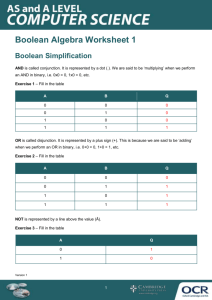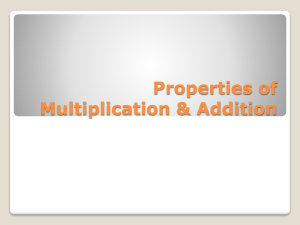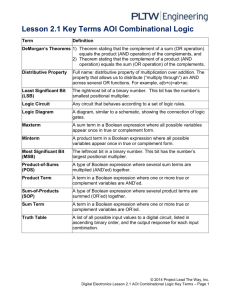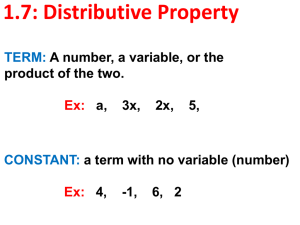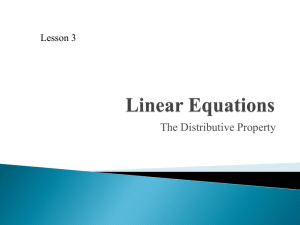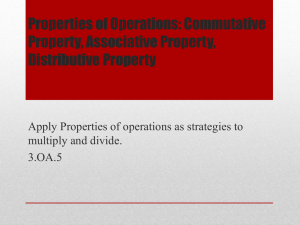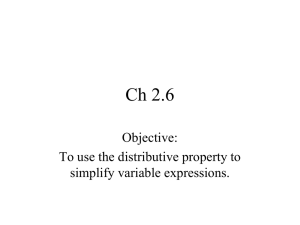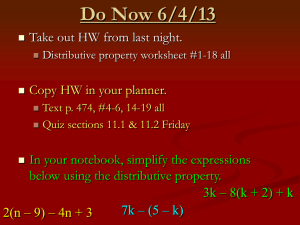Boolean Algebra: Transformations and Summary
advertisement
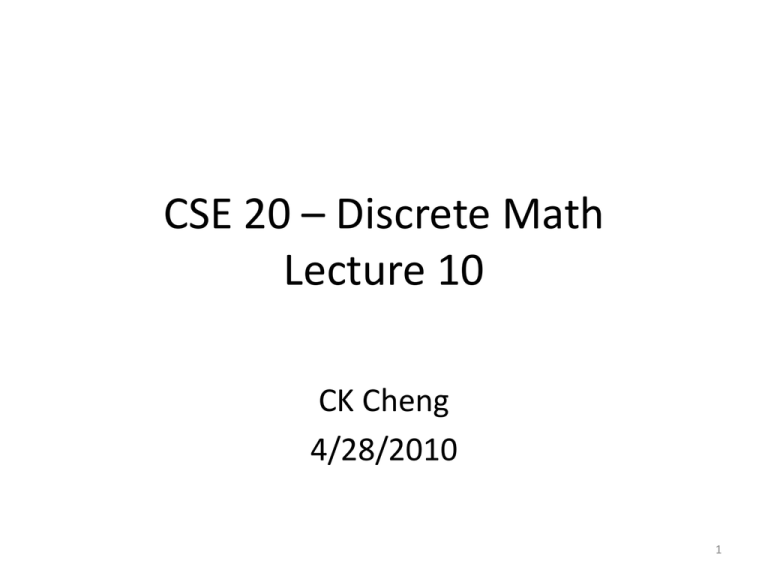
CSE 20 – Discrete Math
Lecture 10
CK Cheng
4/28/2010
1
Boolean Algebra
Theorem: (Associative Laws) For elements a, b, c
in B, we have a+(b+c)=(a+b)+c; a*(b*c)=(a*b)*c.
Proof: Denote x = a+(b+c), y = (a+b)+c.
We want to show that (1) ax = ay, (2) a’x = a’y.
Then, we have x= 1*x=(a+a’)x= ax+a’x = ay+a’y=
(a+a’)y= 1*y=y
Shannon’s Expansion: (divide and conquer) We
use a variable a to divide the term x into two
parts ax and a’x.
2
Proof of (1) ax = ay
ax = a (a+(b+c)) = a a + a (b+c) (Distributive)
= a + a (b+c) (Idempotence)
= a (Absorption)
ay = a ((a+b)+c)) = a (a+b) + a c (Distributive)
= (aa + ab) + ac (Distributive)
= (a + ab) + ac (Idempotence)
= a + ac (Absorption)
= a (Absorption)
Therefore: ax = a = ay
3
Proof of (2) a’x = a’y
a’x = a’ (a+(b+c)) = a’ a + a’ (b+c) (Distributive)
= 0+ a’(b+c) (Complementary)
= a’(b+c) (Identity)
a’y = a’ ((a+b)+c) = a’ (a+b) + a’ c (Distributive)
= a’b+a’c (Theorem 8)
= a’(b+c) (Distributive)
Therefore: a’x = a’(b +c) = a’y
4
Boolean Transformation
Minimize the expression: (abc+ab’)’(a’b+c’)
(abc+ab’)’(a’b+c’)
=(a(bc+b’))’(a’b+c’) (distributive)
=(a(b’+c))’(a’b+c’) (absorption)
=(a’+bc’)(a’b+c’) (De Morgan’s)
=a’b+a’c’+a’bc’+bc’ (distributive)
=a’b+a’c’+bc’ (absorption)
5
Boolean Transformation (switching function)
• ab’+b’c’+a’c’= ab’+a’c’
Proof: ab’+b’c’+a’c’
= ab’+ab’c’+a’b’c’+a’c’
=ab’+a’c’
y=ab’+a’c’
We can use truth table
when B={0,1}, which is
the case of digital
logic designs.
id a b c ab’ b’c’ a’c’ f
0 0 0 0
0
1
1
1
1 0 0 1
0
0
0
0
2 0 1 0
0
0
1
1
3 0 1 1
0
0
0
0
4 1 0 0
1
1
0
1
5 1 0 1
1
0
0
1
6 1 1 0
0
0
0
0
7 1 1 1
0
0
0
0
6
Boolean Transformation (switching function)
• ab’+b’c’+a’c’= ab’+ab’c’+a’b’c’+a’c’= ab’+a’c’
id a b c ab’ b’c’ a’c’ f
0 0 0 0
0
1
1
1
1 0 0 1
0
0
0
0
2 0 1 0
0
0
1
1
3 0 1 1
0
0
0
0
4 1 0 0
1
1
0
1
5 1 0 1
1
0
0
1
6 1 1 0
0
0
0
0
7 1 1 1
0
0
0
0
b,c
0,0 0,1 1,1 1,0
a=0
1
0
0
1
a=1
1
1
0
0
K Map (CSE140)
7
Boolean Transformation (switching function)
• (a+b)(a+c’)(b’+c’)=(a+b)(b’+c’)
id a b
c a+b a+c’ b’+c’ f
0
0 0
0
0
1
1
0
1
0 0
1
0
0
1
0
2
0 1
0
1
1
1
1
3
0 1
1
1
0
0
0
4
1 0
0
1
1
1
1
5
1 0
1
1
1
1
1
6
1 1
0
1
1
1
1
7
1 1
1
1
1
0
0
b,c
0,0 0,1 1,1 1,0
a=0
0
0
0
1
a=1
1
1
0
1
K Map (CSE140)
8
Summary of Boolean Algebra
• Definition: a set B, two operations and four
postulates.
• Applicability: set operations, logic reasoning,
digital hardware synthesis and beyond.
• Theorems: all proofs are derived from the four
postulates.
• Transformations: Boolean algebra for the
hardware designs (cost and performance).
• Switching function: truth table, K map (CSE140)
9

